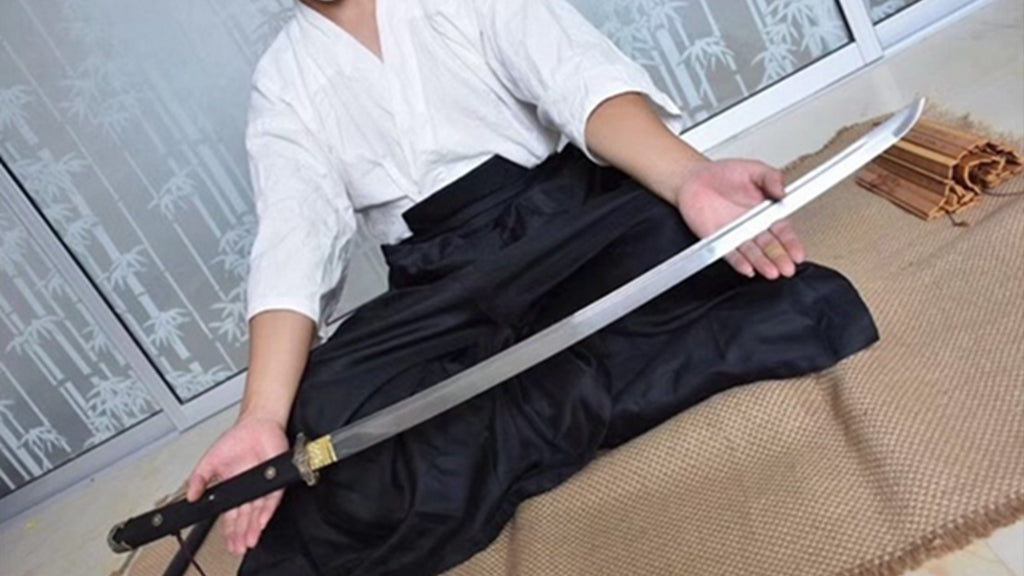The Evolution of Katana Sword

The shape of the katana sword has changed a lot from the late Heian period, through Kamakura, the Southern and Northern Dynasties, Muromachi, Azuchi Momoyama, the early, middle, and late Edo period. It is mainly manifested in the transformation from the straight knife to the machete. The straight knife is suitable for stabbing, and the machete is suitable for slashing. The reason for such a change is mainly caused by the change of fighting style. Since the end of the Heian period, knives have been continuously improved in order to be suitable for immediate combat. In the production of Japanese swords, from the late Heian period to the Kamakura period, Yamato Kingdom, Bizen Kingdom, Yamashiro Kingdom, Sagami Kingdom, and Mino Kingdom appeared in five major centers and famous craftsmen from all over the country.

1. katana sword in ancient times
In the middle of the Kofun period (200-771) in Japan, iron swords had already appeared, and the raw materials at that time were mainly iron smelting. For example, the Mt. Inari burial mound of Saitama and the orogenic burial mound of Shimane have both iron swords unearthed. The "Jin Cuo Ming Iron Sword" unearthed from the ancient tomb of Mount Inari was made in 471 AD to commemorate the merits of serving Emperor Yuroku. There are 115 Chinese characters engraved on the sword. Most of the swords of this era are rusted.
Swords before the end of the Heian period were classified as ancient swords, and the shape of the katana sword was different from the common Japanese swords today, either with a straight edge or with a double edge. Ancient knives are extremely rare and are important archaeological materials. The Japanese sword originated from the ring sword in China. The steel forging process of the horizontal sword introduced into the mainland and Korea in the fifth and sixth centuries is the origin of the Japanese iron sword forging process. At the same time, combined with the fern hand sword of the Ainu people in Hokkaido, it belongs to the original Japanese. The number of swords left over from the early Heian period is quite small, and the raw material is changed to slightly roughened milled iron, and the appearance remains the same as the bar. Questions such as academic changes in Japanese sword styles, and when and how Japan created the unique machete, have not been fully explained. It is generally believed that after the Chenghei Rebellion and Tenkei Rebellion in the middle of the Heian period (around the 10th century), the straight sword gradually changed into a machete.
2. The katana sword of the Taidao era
In the latter part of the Heian period, especially during the period of the "First Nine Years Campaign" and "Later Three Years Campaign" when the samurai forces were most active, the forces of the samurai family increased, and the katana sword developed greatly. For example, in Hoki and Bizen, which produce high-quality iron ore, and Yamashiro and Yamato, which are political and cultural centers, different schools of knife craftsmanship have appeared. At this time, Japanese swords were mainly used for immediate decisive battles, so they were mostly Taida swords. The representative works of this period include "Doujikiri" (An Tsunashi of Boqiguo, Japan's national treasure), which killed "Shouten Douji" in Dajiang Mountain, and "Little Fox Pill", which is said to have been created by a fox. (The Sanjo sect of Yamashiro was destroyed during World War II). In addition to Anzuna, Sanjo Koye Sokin in Yamashiro (present-day Kyoto), Kobizen Yusei, etc., are considered to be the oldest swordsmanship works with the maker's name inscribed.
The Japanese sword in the early Kamakura period was similar to the end of the Heian period. The establishment of the samurai political system of the Kamakura shogunate made the sword world very active. Later, Emperor Toba even set up Yufan forge, and Yueyue recruited swordsmen to forge swords and actively encouraged sword-making. In the middle of the Kamakura period, due to the emphasis on usability, the width of the blade was wide, and the overall width changed little. The blade cuts the pig first, and the quality is really strong. At this time, the production of short knives began to flourish. At the end of the Kamakura period, the social turmoil brought about by two Yuan army invasions and the collapse of the original political system made the knife industry prosper. The Japanese swords of this period were more bold than the mid-Kamakura style. Inherited and carried forward the characteristics of wide blade width, small change in blade width, and longer cutting edge. Short swords, katana, and tai swords all have the same characteristics of appearing longer than other periods. During the period of the Northern and Southern Dynasties, a large number of large swords called Otachi and Notachi appeared different from the past. Therefore there are many types of katana swords. Choose one that you like.
3. After Muromachi katana sword
After the middle of the Muromachi period, the Japanese katana sword changed from a tachi with a downward blade to a katana with an upward blade. Due to the transition to peacetime, the demand for Japanese knives decreased, and Japanese knives began to be mass-produced as trade goods, so the quality of Japanese knives began to decline. After the war caused by the Onin Rebellion, the demand for swords has expanded again. In order to meet the demand, a large number of shoddy products have appeared, which has caused the quality of Japanese swords to decline even more.
In the Edo period, the forging industry in Edo (now Tokyo) and Osaka prospered, and famous swordsmen from all over the country emerged. As the peaceful and prosperous times continued, Japanese swords began to blindly pursue gorgeous blade writing, and gradually separated from the essence of practicality. In addition, in this era, the decoration of knives such as tan, small handle, eye kan, and Ji began to develop.






